太空朋克猫 Tamala 2010:A Punk Cat in Space(2003)

又名: 朋克太空猫
导演: Tol
主演: Béatrice Dalle Takeshi Kato Takeda Shinji Hisayo Mochizuki
制片国家/地区: 日本
上映日期: 2003-09-28
片长: 91分钟 IMDb: tt0374262 豆瓣评分:7.7 下载地址:迅雷下载
演员:
影评:
看完先自行捋一下剧情,然后再看评论真的坐不住,说到靠谱的我看就这句行:
“tamala不是fritz,'punk'不如hippie.“
——
但是这家伙打了三星我就不明白了...
绝对五星好吗!
为什么,容我娓娓道来。
这个多人物线,多时间线的影片,必须让我们分头把人物的命运线捋顺:
小喵塔玛拉,漂亮的玛丽莲梦露
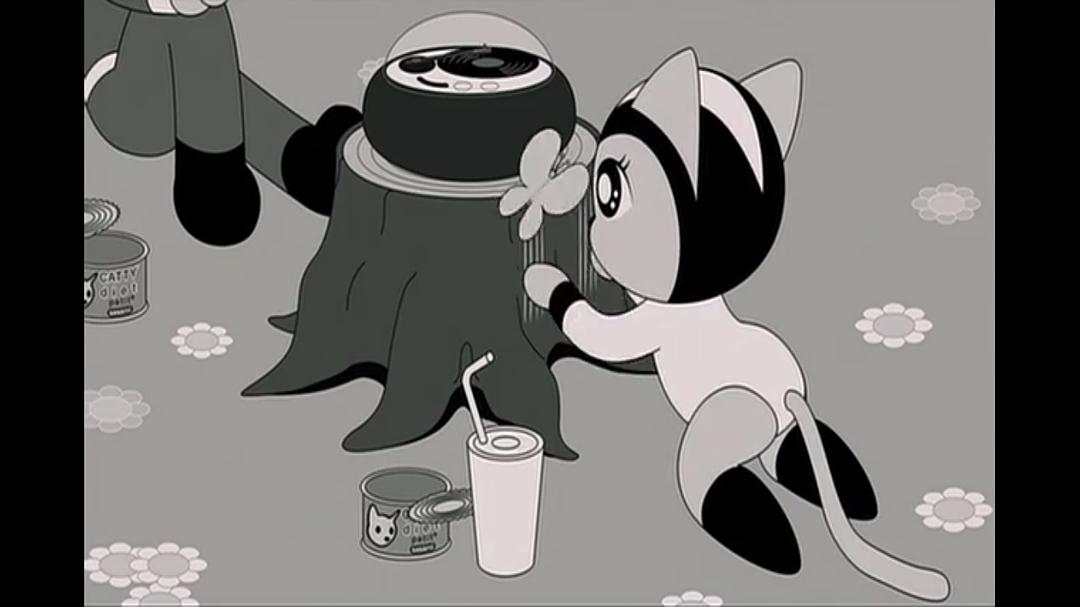 塔玛拉
塔玛拉这只活成精的性感喵,塔玛拉,有着非常标志性的特征,比如爱抽烟,随心所欲,自带凯鲁亚克精神,今天掉在Q星今天就享受Q星,明天说要去猎户座起身就走。
享受磨爪子,爱犯困,万人迷,跨星球巨牌签名大明星,渴望平凡爱情,纯真可爱死神被招呼一下都不行,滑板保龄球随便溜,随便上台跳段舞都能拉起一个万人演唱会。
看展览看到代表破坏与再生的神话女神塔玛拉——其实也正是操控她的机械教母原型——手臂上有个神秘图腾之后,分分钟找了家纹身店纹到了自己胳膊上,而且一边告诫身旁的男朋友:这丫是我自己设计的。
完美确认自己的身份,一点都没有存在主义上的任何疑问,这一点实在好过在座的各位男性(我是指影片里)
种种这般放在今天也是当代21世纪时髦女青年,不是你们各个追求的酷女孩吗。梦露般的存在,你和我说不时髦?
她这个家也很有内涵,墙上这个左边是蛾类(蝶类?)幼虫的解剖图,不知道是不是映射她最后还是选择飞向自由的结局。
头顶这个明星是个谁需要科普,应该是电影或者音乐明星之类,旁边一整套完美的old school音响,这么高配置你和我说不时髦?
 塔玛拉的家
塔玛拉的家(另外,梦露喵和男主角遇难前听的那个播放器也很高级)
让我们再认真确认一下塔玛拉的生平。 梦露喵,喵星公历1869年7月29日,出生于猎户座希腊市,由真正的喵生育,年龄始终活不过一岁,反复卒于百年之后,死因有可能是被一只恶犬咬死。这是她永恒的宿命,就像耶稣必须要流血受难一样。
1869年7月29日这天夜里,神秘的邪恶宗教古代密涅瓦教制造了一场大火,带走了这个市区二十万只刚出生的喵(相当于我们“人类”这个概念了,完全丧失伦理道德惨无人性),只为了拣选出他们的“献祭品”———即能够注入塔玛拉程序,给人们带来混乱、战争与革命的天选宝宝。 不幸中的万幸,万幸中的不幸,我们的女主角,梦露喵最终成为了这1/20W+,带着混乱的基因,包含着渴望自由的内心降临在了世间,承载着密涅瓦教教徒的罪孽,替这些邪教徒反复死在一周岁。
就这样反复重复了数百年,直到塔玛拉自我意识觉醒,即她一百年的男朋友米开朗基罗发现整个事件持续百年的奥秘(也就是我上面讲的这一堆)之后,塔玛拉体内的追求自由、向往母星的心终于按耐不住,从机械教母设定好的程序中逃脱,乘坐太空飞船前往了朝思暮想的出生之地——猎户座。
然后我们总结一下小喵塔玛拉能不能称得上太空朋克猫。
从这一点来说,如开头所述的朋友观点还是十分精准的,塔玛拉作为神话故事里破坏与重塑的女神,事实上并没有从本质执行破坏与重塑。
从破坏角度来说,梦露喵只是性格较酷偶尔破坏个车门、抛个媚眼惹来杀身之祸啥的,但这和机械教母“塔玛拉”动不动杀二十万只喵做实验,放放低波频率带来城市星球大战,这种破坏真的是洒洒水,过家家一样。
从重塑角度来说,故事结尾梦露喵从机械程序的反复中逃离,但她并没有挑起大梁站到机械教母的对立面,带来世界和平,而是仅仅回到了母星,拯救了自己的命运。
从小喵塔玛拉的生活方式来看,确实称得上是一只嬉皮士喵,周游太空,随遇而安,但,并不能称之为朋克猫。和朋克是根本上的区别,与怪猫菲力兹 Fritz the Cat (1972)应该是不可同日而语的。
就这点来说确实人物有点弱鸡,但并不招人反感,毕竟小喵塔玛拉也是很饱满一个人物啊,只是团队可能对朋克VS嬉皮有什么误解。
男朋友米开朗基罗,刘海卷发似羔羊
首先,让我们了解一下米开朗基罗是谁。
米开朗基罗,先是以雕刻家的身份稳定了自己艺术家的地位。1499 年创作的《哀悼基督》是他的成名之作,解剖学科的艺术实践和细致入微的匠心独运吻合了、甚至超出了人们可以理喻的"鬼斧神工",被誉为 15 世纪最动人的人性拥抱神性的作品-出示了悲剧却掩饰了哀伤。这一时期的另一件作品是创作于 1501 年的《大卫》-神化的人形已经确立(百度百科)。
文艺复兴时期最提倡的即使人作为“个体”自我意识的觉醒,这个名字其实很符合男主角喵的生命线。
以生命轮回的刻刀塑造了小喵塔玛拉的自我意识觉醒,也是自己的自我意识觉醒(虽然人到暮年幡然醒悟,为时已晚);另一方面,小喵作为耶稣受难者的形象也被男主角喵深刻理解,因此爱的更深,追求小喵塔玛拉类似于追求“神”,将小喵塔玛拉作为自己毕生挚爱甚至是信仰都不为过。
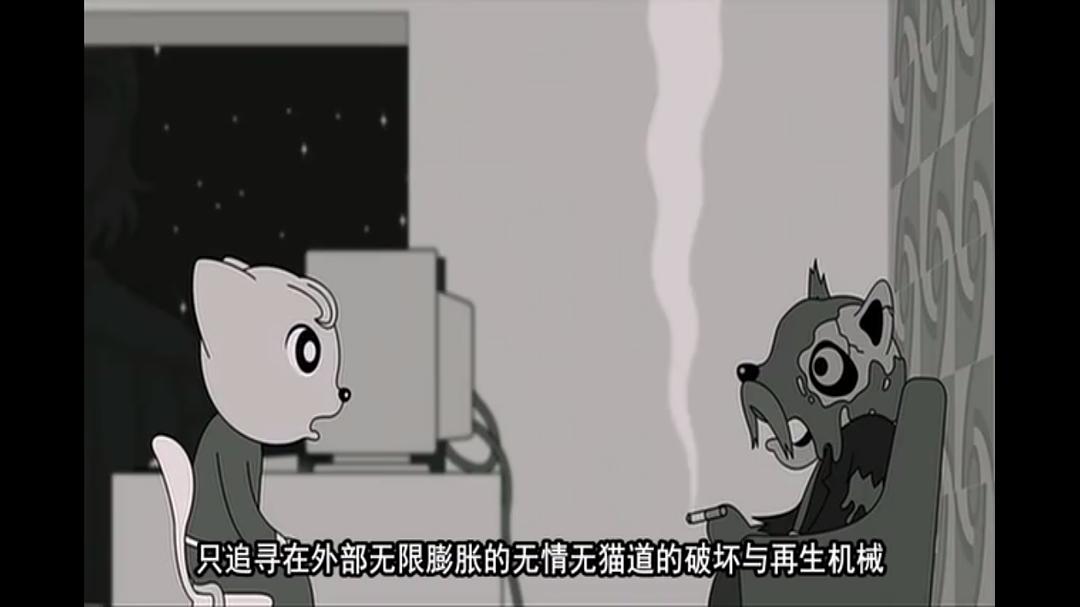 老年莫莫告诉青年莫莫真相
老年莫莫告诉青年莫莫真相米开朗基罗的一生其实非常简单,典型的二五八万拿不起放不下男,蠢得一批,我们姑且按照小喵塔玛拉的爱称,称之为莫莫(我去,和陌陌真是不谋而合)。
莫莫和梦露喵在一个晴朗的大白天相遇,身欠巨款信用卡刷爆但是仍旧开着拉风的奶牛车,买着停车位的莫莫正如种种不耻的装X男一样,张口就是和我们单纯可爱的梦露喵聊伊斯特伍德,没想到被我喵一句“我就是他”给生怼;
嘴上口口声声说自己对发情这种东西毫无兴趣,身体倒是很诚实地盯着博物馆两颗大胸部紧紧不放(可能是没办法表现猫的胸部吧);
表面上对梦露喵冷冷淡淡实际上风骚起来真是叫人害怕,带着我们的梦露喵又是蹦迪又是艳舞玩得相当摩登,当天晚上就承蒙梦露喵主动献身把人(喵)给睡了;
信誓旦旦说危险来了当然出手救你的男喵,果然在生死关头说跑就跑,眼睁睁看着前一秒还和自己煲音乐磨爪子的可爱萌酷怎么看都喜欢的女朋友,后一秒就被尾随而来恋童癖的狗警察生吞活剥,留下了两颗硕大的眼泪,并且头也不回的逃跑了;
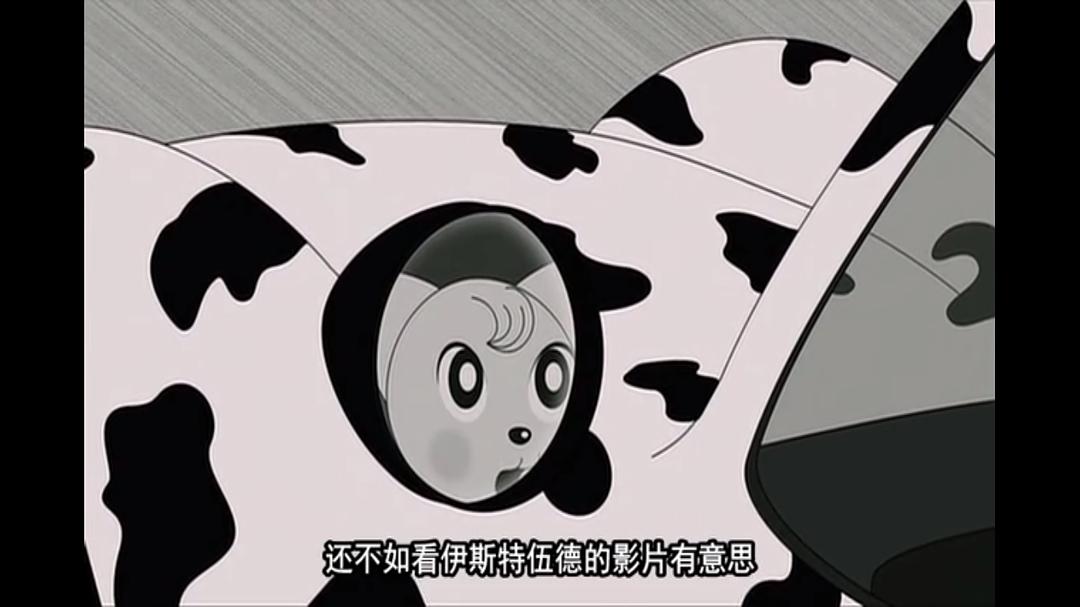 男人都是大猪蹄子
男人都是大猪蹄子这么一看这么蠢的喵究竟是怎么被我们那么可爱的女主角喜欢上的啊,可能自古美人难过渣男关,但是莫莫也有其可爱之处。
因为痛失女友加亲眼目睹暴力的精神刺激,莫莫没有再继续鬼混,而是致力于发现、研究、探索小喵塔玛拉的一生,追寻其轨迹,最终发现世界真相,写成了学术巨作《存在于资本主义体制下的流通与否定神学:猫氏集团与古密涅瓦教的相似性》。
说真话,就这名字,拿到现在的哪个学校开讲座或者谁的毕业论文,我一点都不带怀疑的。
这本书的成就不亚于柏拉图的山洞隐喻,揭示世界本质,看透事件真相,将机械教母塔玛拉的丑陋面目公之于世,当然,其结果也与柏拉图无二。
PPT讲到一半的时候,果不其所然着起了大火,我们的米开朗基罗虽然没至于像柏拉图一样立即被烧死,但也只剩了残胳膊断腿,无人相信他的研究(虽然那么多证据摆在眼前你瞎啊),最终,他决心敲开青年莫莫的房门,从源头解决问题,试图告诉青年莫莫真相。
此时的老年莫莫早已置生死于度外,但仍旧没有改掉装X的毛病,时不时插播一句“我什么都知道”,你什么都知道你算不出来你最爱的女人在哪儿啊最恨装X男了,青年莫莫果然和我想的差不多,一边听得直打瞌睡,一边想着怎么把这个满身是蛆的二五八万打发走,所以压根儿不相信老年莫莫苦口婆心的促膝长谈,继续蜷缩在自己的安全世界里做一个懦弱、沉迷A片儿、欠钱不还、脸皮巨厚的装X男。
而电脑另一端也显示着程序的彻底装载完成,几个时空里的莫莫,同样作为不死之身,与小喵塔玛拉有过短暂甜蜜的回忆后,最终都因为懦弱失去了自己一生最爱的女人。这是机械教母赋予他装配的程序。
(所以男人们不要装X了拿出点实际行动好吗?!你们怕不是感染了塔玛拉病毒了吧?!)
唯一了解了世界真相的老年莫莫,终于改写了属于自己(这个时空的这个莫莫)的历史,新的一天开始了,被死狗虐待的性感老鼠逃出生天,与新一轮出生的小猫塔玛拉走向了自由。
自我觉醒的小喵塔玛拉正是老年莫莫魂牵梦绕、一生执念,与他青年错失的爱人无异,至此,老年莫莫也完成了他毕生的心愿——与她再见一次。
可惜的是,嬉皮小喵塔玛拉打了个哈欠,也不管懦弱的青年莫莫目睹她的重生之后三观如何崩裂,也没管老年莫莫殷切的眼神,一脚踢上去,带着老鼠,两个不幸的人最终离开了喵间炼狱。
次要人物
作为次要人物,其实也有必要捋一下。
人类母亲,热爱蟒蛇的人妈
 蛇蝎养猫人
蛇蝎养猫人这个妈看起来挺酷的,全身缠着蛇,长得又好看,但是蛇自古以来就和基督教水火不容,代表邪恶的化身,这个妈也没好到哪里去。
人类母亲说白了就是监视小喵塔玛拉,还盘算着拿它换别的喵,盘踞在小喵的住所里各种侵犯隐私,得知对方要前往猎户座分分钟派邮船开炮陨石击落对方,作为养母收养了塔玛拉之后就把它献祭给了机械教母,完全没有任何同情心,和我们现在挺多养猫养狗的人倒是挺像。
但小喵也不甘示弱,一边飙粗口,一边把(疑似莫莫或者什么调查者寄来的)明星片转手寄给对方,“再您妈的见了”。
机械教母塔玛拉,全身机械化的喵教母
 升入天空的断臂无头机械人相当赛博朋克了
升入天空的断臂无头机械人相当赛博朋克了全程背后操控者,影片时不时转播一下其幽绿幽绿的眼睛,以证明世界无时不刻不在其掌控之中。
专业制造诱拐、恐吓、战争,拥有全世界最大的跨国集团,情报贩子一把手,沉迷扩张业务板块无法自拔,通过各类超循环低周波(虽然我也不知道这翻译的是个啥玩意儿)控制全世界制造不安情感,只有<1year之下的小朋友做梦能看到对方的脸而被噩梦吓哭,很快就要掌握全世界GDP挤压所有不利选手,邪教教母,手底下各把号人都是类似刘华强的手下。
 这面墙真是涨见识了1
这面墙真是涨见识了1小喵塔玛拉的母系,操控者,博物馆壁画杀害众多喵喵(实打实的N多虐猫画面)的罪魁祸首。结局甩下一句“你还会回来的”火箭队式谢幕。
警察狗VS老鼠
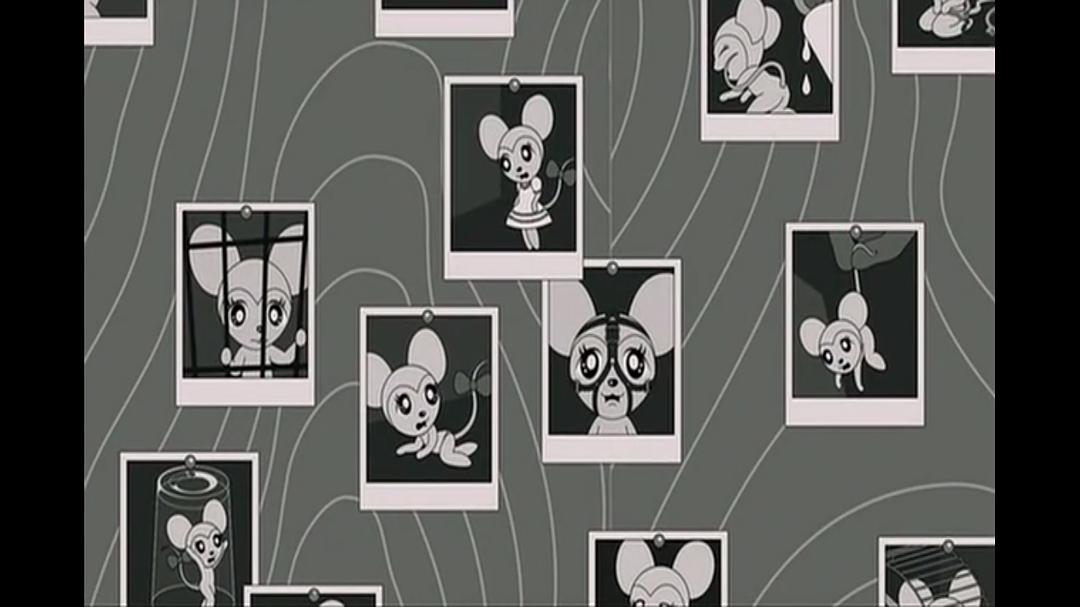 这面墙真是涨见识了2
这面墙真是涨见识了2欺负老鼠的不一定是猫,本片里唯一出现的一只老鼠就是一个标准的性奴。被一只双性恋/恋童癖/跟踪狂/一天到晚只知道健身和强迫老鼠拍色情照片的狗关在精致的笼里无法脱身,当然,最终她终于逃出牢笼,与小喵共同前往猎户座。
值得一提是老鼠的名字,珀涅罗珀(Penelope),出自《奥德赛》,资料显示是对爱情忠贞不渝的意思。也很值得思索。
这个承担了全部坏人角色的警察狗故事线很清晰,不多说了。
 这个城市的小孩倒是挺朋克
这个城市的小孩倒是挺朋克邮差喵
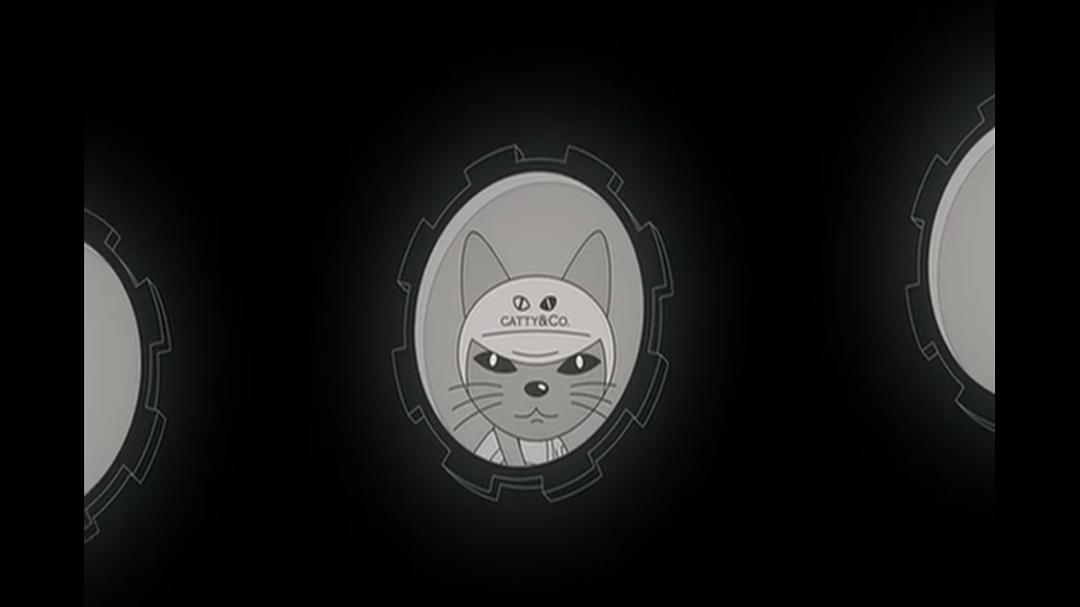 监视这么多年,也是爱啊
监视这么多年,也是爱啊和小喵塔玛拉,莫莫共同存在于几百年历史中的一员。从百年前的送信员一直到现代社会里的邮差,古老的职业还肩负着监视小喵塔玛拉的使命,终于也在一次次的打压中感到腻烦,最终放走小喵,在远处的星空中凝视着对方远去。
全部人物线捋完,整个影片其实可观赏性很高,光是赛博朋克和old school的场景就让人觉得特别,中间穿插着白描、小说式的自述以及街边两个靠闲聊打发时间的喵女郎,都为故事的文学性增加了不少色彩。

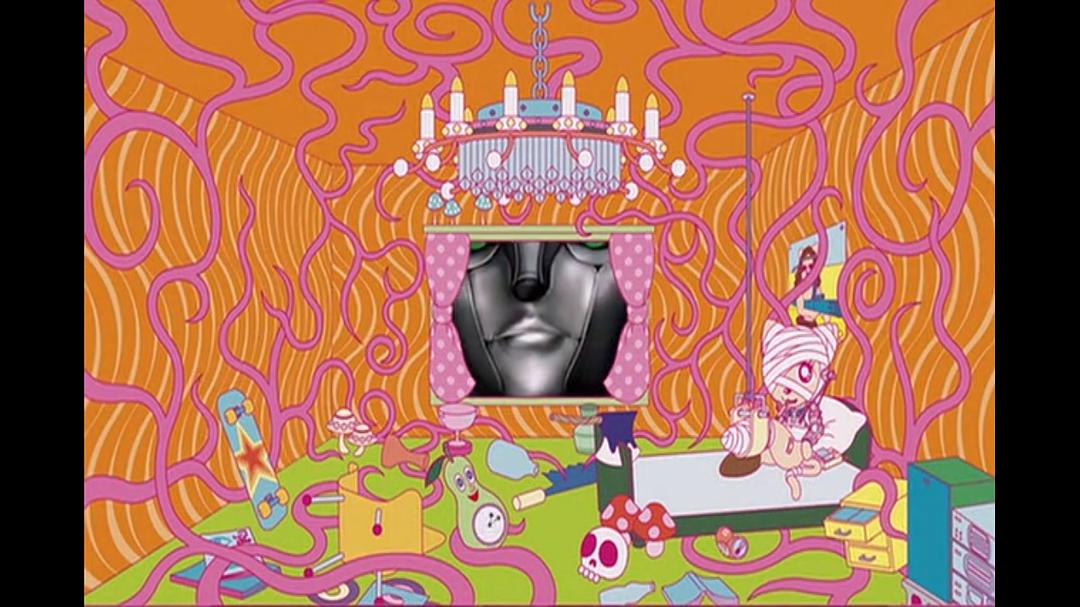
答案写在一切开始之处。
序篇有言:
「一只来自于密涅瓦诗篇中的黑暗之猫」
最后根据豆瓣网友搜了下歌曲,TOL乐队,这个封面真是配合旋转效果聆听蜜汁邪教主题曲之感。
 网易云有,虾米有另外一首《ONE DAY FOR MARIA》但是显示是日本群星演唱
网易云有,虾米有另外一首《ONE DAY FOR MARIA》但是显示是日本群星演唱查了查密涅瓦,可能黑格尔的这句“密涅瓦的猫头鹰要等到黄昏到来,才会起飞。”和本片有神秘的联系,具体解读还看各位哈姆莱特了。唯心论符合宗教问题。
old school是块宝,奶过的人都说好。MD不知不觉竟然写了一夜,诸位晚安。
(留坑待补,有时间把隔壁那篇不错的拜物主义翻一下
- 片名:《太空朋克猫》TAMALA 2010: a punk cat in space
类型:动画/奇幻/科幻/音乐
出品:mk2
导演:t.o.L
监制:塚田诚一 三尾和子 t.o.L
原作:t.o.L
脚本:t.o.L
音乐/制作/监督:t.o.L
人设:根本健太郎 t.o.L
片长:92分钟
剧情:
2010年,在另一个平行宇宙里,我们地球的居民全都是猫。在这个所谓“猫星系”的 “猫地球”上,有一个几乎垄断全球经济的巨型集团:猫氏企业(Catty & Co.)。在猫地球日本的目黑城的権乃助坂里,住着一只天真可爱的1岁小猫Tamala。有一天,她独自一人乘太空船离开地球,驶向猎户星座。她的“人类母亲”不许她前去,暗中派了一只邮递猫跟踪并阻止她,邮递猫向Tamala的飞船发射了一枚小流星,就这样,Tamala被打落在Q星球上。
Tamala在Q星球的某公路上邂逅了雄猫米开朗基罗,他开车搭 Tamala到最近的城镇去。虽然米开朗基罗很不满Tamala每次都称呼他叫“莫莫”,但两人还是成了朋友,后来他们在一个由于常年动乱而破败不堪的小城——“仇恨城”落脚,他带Tamala看美术馆、打保龄球、泡夜酒吧、飙车,玩得相当开心。
一天,米开朗基罗和Tamala外出野餐,却完全不知有只凶残变态的狗警官健太郎在尾随。健太郎是个很下作的警察,他家里用鸟笼子禁锢着一只名叫珀涅罗珀的小老鼠,一天到晚不是虐待她就是给她穿SM服装,墙上贴了无数给她拍的即时成像照片。健太郎在外头还带着一个同性恋男伴,整天在街上以殴打平民百姓为乐。健太郎看准了时机,凶猛的扑向Tamala和米开朗基罗。结果,米开朗基罗成功逃脱,却远远目睹了Tamala像是被健太郎吃掉了的景象。
米开朗基罗回到城里,以为Tamala已死的他十分沮丧,由于猫氏企业的星际扩张计划已经入侵到Q星球,国家的动乱越发严重。一天,有一只全身腐烂的怪猫拜访他家,煞有介事的告诉他关于Tamala的秘密,原来这只可爱猫咪的背后,还有猫氏企业无止境扩张的背后,竟然隐藏着一个耸人听闻的惊天阴谋……
影评:
首先说明一下,这并不是一部Hello Kitty般的卡哇伊风的少女动画。这只大眼小猫,比我们想象中的更深不可测。
上述的内容简介,只是集中整理出一条主线,实质上该片的情节是典型的意识流,平叙、倒叙、反复、插叙兼而有之,并非看一两次就能完全搞清楚来龙去脉的。用哪些词来概括《太空朋克猫》比较合适?灰冷、压抑、古怪、晦涩、复杂、诡秘、悬疑、无厘头……不一而足。自从艰深难懂的《新世纪福音战士》取得空前成功以来,近年来动画界流行起一些故弄玄虚、连作者也未必能解释透彻的题材,不过,再深奥的作品也不过是人写成的,而非天书,只要每个读者动动脑筋,还是能理出些个人见解吧?在我看来,《太空朋克猫》所表现的最突出的主题就是:垄断与倾销,入侵与反抗。可惜这种反抗到了影片结束时,仍是以失败告终(Q星球最后被猫氏企业成功接管市场)。而主角 Tamala,本身就已经成为猫氏企业——古代密涅瓦教的衍生物——的形象代言,Tamala的形象是不灭的,虽然她自始至终一心要飞往猎户星座,希望脱离这个妄图称霸宇宙的邪恶势力,但可想而知,她必将受到“人类母亲”和猫氏企业更大的阻力。
回到影片的画面风格,确实是很独特。影片的基本色调就是黑白灰,让人不禁联想起早在上世纪60年代的老动画,泛起丝丝回忆。线条简单、单层着色、祯数不多,动作生硬,确实是那个年代动画的最大特点,但是该片绝对没有那个年代画面常见的雪花、噪点和杂纹,因为它是以CG绘制和上色的。虽然通篇以黑白灰为基调,但其中有几个场面突然换成彩色,如高烧的鲜红色大火、美术馆里的壁画、 Tamala在彩色的房间里养伤等,让人眼前一亮,而且过目难忘。除了2D画面,影片的3D动画也做得十分出彩:整个目黑城是由3DCG搭建的钢铁都市,而巨型机械猫人(达特拉女神,是Tamala的机械原型)的构造和质感也相当到位。不过,本片的3D技术精湛,但不滥用,它的2D和3D还是比较泾渭分明,除了达特拉和Tamala交互的几个奇幻式的镜头,尽量避免两种截然不同的风格并存于同一画面造成的不协调感,这一点,的确值得国内某些动辄把2D人物置于3D背景中的动画制作人参考。
在这部古怪的动画里,充满着不少黑色幽默和超现实的元素,幽默元素主要集中在影片的开头部分,譬如将肯德基的上校爷爷,甚至死神也拿来恶搞,但随着Tamala着陆在Q星球,主题就回归严肃了,而且歪风恶气也开始增加,如异装癖、虐待狂、同性恋、残害、群殴、策反、凶杀、腐朽等等,客观反映着现今社会的种种尖锐问题,如果独自一人比较专注地观看,某些镜头还会让你不禁心里渗出一丝寒意。总体而言,《太空朋克猫》未必能迎合多数动画迷的喜好,不过对于艺术电影爱好者而言,或许在本片中能有颇丰富的收获。本片为2004年宜兰国际儿童电影节观摩片,更获法国南特三大洲电影节最佳动画片大奖,可见确有其过人之处。虽然影片风格单纯,但可圈可点之处却不胜枚举,还是等碟友亲自去发掘吧。
也许有人会惊讶于上面的影片资料简介,何以那么多剧务人员都是t.o.L?绝对不是搞错,t.o.L本身是音乐人,而在该片更是从导演、编剧、人设和背景设定,到整个统筹工作,全部一手包揽,就算称他们为全能型的艺术家也不为过。t.o.L是(Trees of Life)的简称,由Mika(主唱)、森田雄三(鼓手)、清水惠介(吉他、贝司)三人组成,2003年以主流出道。紧接着《太空朋克猫》在日本的公映时间,它的电影原声碟于2002年10月25日发行,其中第三首音乐ONE DAY FOR MARIA,出自他们在2002年10月7日的同名SINGLE专辑,这似乎又表明,该影片可以与其音乐专辑相互促进,看来又不像是纯艺术性的电影。
- 这部非常self- referential 的电影是今年日本文化课在讲consumerism的时候pro放的。最开始看的想摔瓶子,但真正做完功课觉得拍的很有料。处于自虐倾向我的final essay选这个电影和日本Noh表演做对比。来试着讲清楚为什么电影中Minerva Cult以拜物教为原型。发上来希望对跟我一样第一遍看完觉得在做死的同学有帮助。:)
(PS:强烈推荐Mcgill EAST212。pro人好到爆。我这么懒整个学期都不缺课就知道这门课真的真的好好玩!)
--CKR
During periods of turmoil, people began to worship idols to eliminate threat of unknown environments and gain security. A fetish is an object that is believed to have supernatural powers. Yet, this fetishism often involves violent ritual. In almost every religion, a fetish is worshipped through the ritual of offering sacrifices. Through the act of killing animals or people, a relation between man and fetish is established. And under the belief that this relation with fetish will protect people from chaos and danger, fear is reduced. However, fetishes are actually the unknown chaos that arouse people’s fear. Paradoxically, the fetish becomes apotropaic, and generates a cycle of fear and desire. To maintain this relation with the fetish, people must continuously offer sacrifices, killing animals then even humans as they believe a stronger relation with fetish can be established this way. (两个文学世界中异化的拜物主义与暴力崇拜: 《蝇王》与《黑暗之心》的比较研究 (英文) 《世界文学评论》2008年第02期) Commodity fetishism is a theory proposed by Karl Marx based on the idea of fetishes cult. Commodity fetishism is the idea that people attached an intrinsic value to the commodity rather than the use value. By consuming the commodity, the ritual is performed, therefore, a relation between human and fetish, the sign value, is established. (Isaak Rubin, Essays on Marx's Theory of Value. Montreal: Black Rose Books, 1990, 5). That is to say, people are not only buying a commodity but also a relation with symbol. In Japanese culture, fetish can find its origin in the image of the non-human, for example, oni. This unknown evil supernatural spirit could be subdued and brought over to one’s own side as a protection god. (Lecture)When we look at the analogy of the non-human figures we will see the lineages relating to this fetishism. In my essay, I will discuss two non-human features from Edo period and 2010 respectively. The first one is Unai’s ghost from the Noh play, The Sought-for Grave. The second one is the cute cat, Tamala, in Tamala 2010: A Punk Cat in Space. These two non-human characters are both representations of sacrifice in fetish cults. Noh performance, announced as official by Tokugawa government, is similar to a ritual of fetishism cult. People’s acceptances of Unai’s ghost being forever condemned resemble the ritual of sacrifices, thereby, creating a relation with the fetish. In return Tokugawa as their fetish will provide them protection. Moreover, Tamala, the cute cat fetish, implies commodity fetishism. Through the cycle of consumption and production which resembles sacrifice ritual, desire for Catty&Co. products spreads via Tamala. Then, Tamala as an immortal character gets eaten implying the ritual is complete. Widely consumed Catty&Co brand commodities result in economic colonization of the planet Q. Finally, the immortal Tamala comes back to life, and a new cycle of monopoly capitalism begins. (Lecture)
Fire is a metaphor of desire. Unai’s ghost and Tamala are both born from the fire of desire. (Lecture) The Sought-for Grave, a Noh play written by Zeami, tells a story about Unai. Unai drowned herself after declining to choose between two men who wrote her love letters at the same time. These two men then committed suicide by stabbing each other. Unai's ghost bears the karmic responsibility for two men’s demise, and therefore is forever condemned in Eight Great Hell. The priest’s prayers are of no avail. (Matsukaze, Donald Keene, 39-49) Unai’s ghost is unable to escape from the Burning House (preoccupied by desire and the mortal world). Her desire and attachment to the world is punished and repressed. And this punishment will come to her ghost every time the play begins. This creates an unreachable feeling because she always remains in the past. In other words, the desire and attachment to the world is repressed and enclosed in that absolute past. This is a typical ending of all Noh plays: often, the play is in the night, dark (when ghosts exist) and when the morning comes, the ghost vanishes, yet the Buddhist enlightenment doesn’t come. The Tokugawa period is a turbulent time. Tokugawa is a family of “hereditary military rulers who governed Japan during the Edo period”. This family made Noh the official ceremonial art of the state to create their own authority by instilling the “enclosed temporality” through Noh play. (Lecture) By this I mean in Noh, the absolute past is unchanging and time is cyclical and repetitive, therefore, cut off from the historical present. Noh performance is similar to a ritual of a fetishism cult, infinitely repeated. Unai’s ghost, forever condemned, is the sacrifice. By agreeing with this story and acceptance of Unai’s punishment, people are assumed to create a relation with Tokugawa government which will provide them protection.
In contrast, Tamala is a cute female cat born at “the red night of Edessa”, the big fire on planet Orion. This suggests that the birth of Tamala is equal to the genesis of desire. Sign value is the value attached to an object because of the social status that it imparts upon the possessor rather than utility or function. Tamala is a representation of the sign value of Catty.Co. Against the wishes of her human mother, Tamala flies to her birthplace, Orion. However, the Postcat shoots down her ship and Tamala lands on planet Q. This represents that Catty&Co begins sowing seeds of desire for its products via Tamala on planet Q. Tamala then meets Michelangelo, a male cat. He drives Tamala to the Hate City, a city dissolving into widespread violence between dogs and cats. This resembles the chaos of fetishism cult, it’s the underpinning of people’s desire and fear and the reason for the existence of attachment and relation to fetish as well as ritual. Michelangelo and Tamala first go to visit a museum of animals which is exhibiting human civilization. Tamala discovers a painting describing the sacrificial rituals of the ancient Minerva cult religion and the ruins of a statue of Tatla, the Goddess destroyed and reborn in infinite succession. Minerva cult is in fact a fetishism cult. The mass killing of cats in Minerva cult is the sacrifice ritual in fetishism. In fact, Tamala is Tatla’s reincarnation. The evidence from the following plots support this idea: after Tamala sees a tattoo on Tatla’s arm, she gets one on her arm too, saying: “The octopus tattoo is my original.” Another evidence for the connection between Tamala, Tatla, and Minerva cult are the plot of Tamala dancing like a super star and everyone is shouting: “TATLA!!TAMALA!!Catty!! Minerva!!”
When Tamala tells Michelangelo about her birthplace, Orion, she said to him: “Moimoi, me very tasty. Wanna eat me?” This is one implication that Tamala is supposed to be consumed. Another more direct evidence is that Kentauros, a sadistic dog dressed as a motorcycle cop attacks and eats Tamala while Michelangelo abandons her and runs away. This is when Tamala, the product, is consumed. In Minerva cult, Kentauros is equivalent to the people in the chaos, doing mass killing to create relation with the fetish so as to satisfy certain desires. By consuming the cute female cat, Tamala, Kentauro completes the sacrifice and he has a fake stronger relation with Tamala. Additionally, the presentation from Professor Nominos reveals that Catty&Co. is an offshoot of the Minerva religion:
This ancient cursed secret religion infests us even now. Repeated destruction and rebirth, the progress of an undying world. Their activity based in a crazed doctrine devoted to live sacrifice. A crazed cult that couldn't avoid persecution and mass killings. Some believers sought revenge and changed their identities to fulfill their pledge. Then, they changed the name to Catty&Co… Just when I was talking about the enigma of Minerva, this enigma fabricates yet another answer. Why you ask? Because I intervened in that riddle wrapped in an enigma. Minerva could be a demon possessed in history!! Then, we are hoping for demons within ourselves.
This suggests that Tamala is the sacrifice in the Minerva culture. The demon possessed in history refers to people’s desire of attaining security through ritual of mass killing. And demons within ourselves are the desire of consuming and establishing relation. Tamala’s recurring ritual sacrifice serves the goals and gives power to The Minerva Cult and its monopoly. In the ending of the movie, Tamala revives and continues her voyage to Orion. Catty&Co’s product branding, advertising, newspapers, and street conversation occupied Hate City imply that the city is taken over by Catty&Co. Another evidence of colonization of Catty&Co. through Tamala is that Tamala renamed a lake on planet Q from Prometheus to Lochness, a lake on CatEarth. (All plots are from Tamala 2010: A Punk Cat in Space).
Taken together, we’ll see a strong connection between Tamala and Unai’s ghost as they both serve the goals and gives power to fetishism through recurring sacrifice rituals. We can come to a conclusion that Tamala as a monopoly strategy of Catty&Co is evolved from the strategy of gaining authority used by Tokugawa government. In other words, in both cases, relations between human and fetishes are established through recurring sacrifices. As a result of this establishment of relation, satisfaction of desire and reduction of fear fueled new desire to sacrifice, consume. A vicious cycle of desire to scarifies form. That is to say, fetishism can be the product of reducing fear and stress from the outside world but at the same time, it can be the origin of violence and terrorism. Furthermore, we will see how the information is controlled in these two cases. The Tokugawa family controls the information by announcing Noh as the official play that people are allowed to access. The Postcat delivering mail in wartime in the beginning of the film; two cats in the bar of planet Q talking about how “direct mail is low” and phones are strange “Always cutting out or suddenly busy”, are all the manifestations of Catty&Co‘s plan of controlling the world by controlling the information. - 看Tamala的标题不禁联想到经典的2001太空奥德赛,当然,看过之后就会发现其实没啥联系。片子的背景在未来的宇宙,但跟人没啥关系,那里的地球是是属于猫的世界,一家叫做Catty&Co.的大型公司控制了猫居民吃穿住用行等日常生活的方方面面,Catty&Co.的广告在每一个角落响起,和复兴里边的阿瓦隆公司倒是很相似。故事的主角是一只叫做Tamala的小猫,某天醒来后她便驾着宇宙飞船飞往遥远的猎户座,但在半途中她的飞船却被Catty&Co.的邮递猫发射的小流量击中降落在Plenet Q行星上,相比猫地球上的未来感十足的高度文明,Plenet Q几乎就是一座地狱——到处充斥着暴力和犯罪,乌烟瘴气,破烂不堪的城市,异装癖,同性恋和暴徒的乐园。所幸Tamala遇到了好心的公猫米凯朗基罗,于是悠闲自在的跟着米凯朗基罗上展览,去野餐,过的悠闲自在。可惜好景不长,Tamala被变态的狗警官盯上了,这家伙不光搞同性恋,而且还嗜好给被他囚禁的小老鼠拍照片。米凯朗基罗误以为Tamala被狗警官杀害而情绪低落,却意外地受到一只垂老不堪,只有一只胳膊,且半边脸都腐烂了的狗的拜访,从他口中,米凯朗基罗才得知原来从在战争中提供邮件服务起家的Catty&Co.的标志就是来源于Tamala——这只永远都只有1岁的小母猫,而认为掌握了信息就掌握了整个宇宙的Catty&Co,其终极目标就是将整个宇宙归于自己的控制之下。然而最终,Tamala终还是摆脱了Catty&Co.的控制,奔向了象征自由的猎户座。
对于影片的主题,我觉得应该就是讲未来社会可能存在妄图通过掌控信息来控制世界的设想,现实中我们所处的正是一个信息社会,互联网的蓬勃发展在讲海量的信息带给人的同时,其负面影响也在逐渐显现,典型的既如虚假信息和垃圾信息等等,时时干扰着人对信息的甄选,实际上当你无法对所接触到的信息做有效的筛选时,那么面对如此巨量的信息,实际结果和信息封锁并无太大区别——最终造成的都是使人和事实的距离越来越远,Catty&Co.既是将此发展成了一种宗教式信仰来进行疯狂的扩张。由于影片在叙事上充满了意识流的方式,经常性的思维跳跃使得片子看起来非常不连贯,翻译质量不佳的英文字幕更是搞得我头疼。这部片子。
整部片子的影像风格非常突出,黑白和彩色的2D画面看似粗糙实则精致,类似于此的试验动画风格似乎很受当下日本动画工作者的喜爱,不少展览上都看得到。此外,音乐更是本片的一大亮点,即便把片子当作一部单纯的多媒体作品来欣赏也相当不错。




